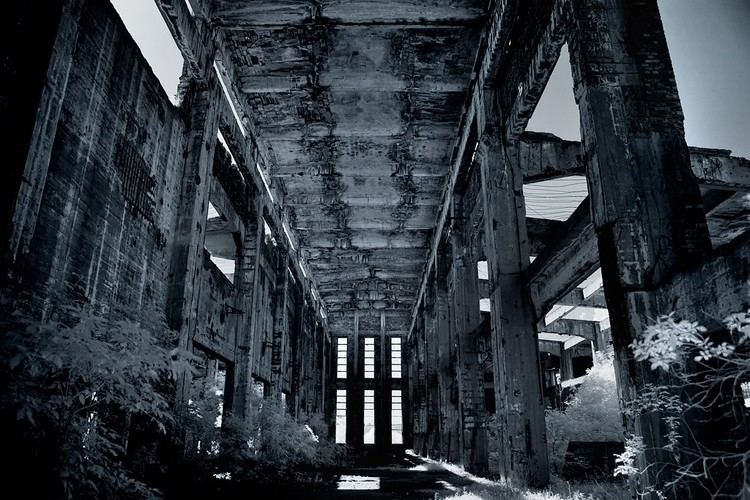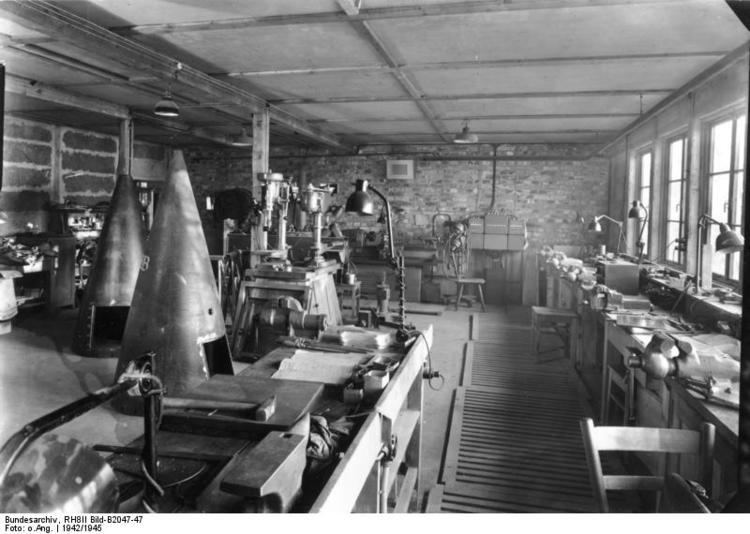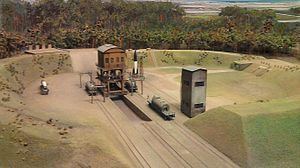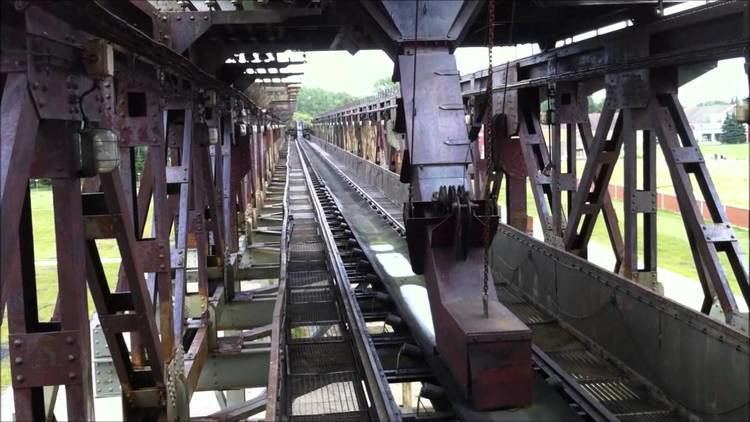Year built 1937 | ||
 | ||
Battles/wars Operation Crossbow (Bombing of Peenemünde in World War II) | ||
The Peenemünde Army Research Center (German: Heeresversuchsanstalt Peenemünde,‡ HVP) was founded in 1937 as one of five military proving grounds under the German Army Weapons Office (Heereswaffenamt).
Contents
- HVP organization
- Guided missile and rocket development at Peenemnde
- Aerodynamic Institute
- Heimat Artillerie Park 11
- Peenemnde V 2 production plant
- Operation Crossbow
- Evacuation
- Post war
- In popular culture
- References

On April 2, 1936, the aviation ministry paid 750,000 reichsmarks to the town of Wolgast for the whole Northern peninsula of the Baltic island of Usedom. By the middle of 1938, the Army facility had been separated from the Luftwaffe facility and was nearly complete, with personnel moved from Kummersdorf. The Army Research Center (Peenemünde Ost) consisted of Werk Ost and Werk Süd, while Werk West (Peenemünde West) was the Luftwaffe Test Site (Erprobungsstelle der Luftwaffe),one of the four test and research facilities of the Luftwaffe, with its headquarters facility at Erprobungsstelle Rechlin.

HVP organization

Wernher von Braun was the HVP technical director (Dr Walter Thiel was deputy director) and there were nine major departments:

- Technical Design Office (Walter J H "Papa" Riedel)
- Aeroballistics and Mathematics Laboratory (Dr Hermann Steuding)
- Wind Tunnel (Dr Rudolph Hermann)
- Materials Laboratory (Dr Mäder)
- Flight, Guidance, and Telemetering Devices (German: BSM) (Dr Ernst Steinhoff)
- Development and Fabrication Laboratory (Arthur Rudolph)
- Test Laboratory (Klaus Riedel)
- Future Projects Office (Ludwig Roth)
- Purchasing Office (Mr Genthe)

The Measurements Group (Gerhard Reisig) was part of the BSM, and additional departments included the Production Planning Directorate (Detmar Stahlknecht), the Personnel Office (Richard Sundermeyer), and the Drawings Change Service.
Guided missile and rocket development at Peenemünde

Several German guided missiles and rockets of World War II were developed by the HVP, including the V-2 rocket (A-4) (see test launches), and the Wasserfall (35 Peenemünde trial firings), Schmetterling, Rheintochter, Taifun, and Enzian missiles. The HVP also performed preliminary design work on very-long-range missiles for use against the United States. That project was sometimes called the "V - 3", and its existence is well documented. The Peenemünde establishment also developed other techniques, such as the first closed-circuit television system in the world, installed at Test Stand VII to track the launching rockets.
Aerodynamic Institute

The supersonic wind tunnel at Peenemünde's "Aerodynamic Institute" eventually had nozzles for speeds up to the record speed of Mach 4.4 (in 1942 or 1943), as well as an innovative desiccant system to reduce the condensation clouding caused by the use of liquid oxygen, in 1940. Led by Rudolph Hermann who arrived in April 1937 from the University of Aachen, the number of technical staff members reached two hundred in 1943, and it also included Hermann Kurzweg of the (University of Leipzig) and Walter Haeussermann.
Heimat-Artillerie-Park 11
Initially set up under the HVP as a rocket training battery (Number 444), Heimat-Artillerie-Park 11 Karlshagen/Pomerania (HAP 11) also contained the A-A Research Command North for the testing of anti-aircraft rockets. The chemist Magnus von Braun, the youngest brother of Wernher von Braun, was employed in the attempted development at Peenemünde of anti-aircraft rockets. These were never very successful as weapons during World War II. Their development as practical weapons took another decade of development in the United States and in the U.S.S.R.
Peenemünde V-2 production plant
In November 1938, Walther von Brauchitsch ordered construction of an A-4 production plant at Peenemünde, and in January 1939, Walter Dornberger created a subsection of Wa Pruf 11 for planning the Peenemünde Production Plant project, headed by G. Schubert, a senior Army civil servant. By midsummer 1943, the first trial runs of the assembly-line in the Production Works at Werke Süd were made, but after the end of July 1943 when the enormous hangar Fertigungshalle 1 (F-1, Mass Production Plant No. 1) was just about to go into operation, Operation Hydra bombed Peenemünde. On August 26, 1943, Albert Speer called a meeting with Hans Kammler, Dornberger, Gerhard Degenkolb, and Karl Otto Saur to negotiate the move of A-4 main production to an underground factory in the Harz mountains. In early September, Peenemünde machinery and personnel for production (including Alban Sawatzki, Arthur Rudolph, and about ten engineers) were moved to the Mittelwerk, which also received machinery and personnel from the two other planned A-4 assembly sites. On October 13, 1943, the Peenemünde prisoners from the small F-1 concentration camp boarded rail cars bound for Kohnstein mountain.
Operation Crossbow
Two Polish janitors of Peenemünde's Camp Trassenheide in early 1943 provided maps, sketches and reports to Polish Home Army Intelligence, and in June 1943 British intelligence had received two such reports which identified the "rocket assembly hall', 'experimental pit', and 'launching tower'.
As the opening attack of the British Operation Crossbow, the Operation Hydra air-raid attacked the HVP's "Sleeping & Living Quarters" (to specifically target scientists), then the "Factory Workshops", and finally the "Experimental Station" on the night of August 17/18, 1943. The Polish janitors were given advance warning of the attack, but the workers could not leave due to SS security and the facility had no air raid shelters for the prisoners.
A year later on July 18, August 4, and August 25, the US Eighth Air Force conducted three additional Peenemünde raids to counter suspected hydrogen peroxide production.
Evacuation
As with the move of the V-2 Production Works to the Mittelwerk, the complete withdrawal of the development of guided missiles was approved by the Army and SS in October 1943. On August 26, 1943, at a meeting in Albert Speer's office, Hans Kammler suggested moving the A-4 Development Works to a proposed underground site in Austria. After a site survey in September by Papa Riedel and Schubert, Kammler chose the code name Zement (cement) for it in December, and work to blast an underground cavern into a cliff in Ebensee near Lake Traunsee commenced in January 1944. To build the underground tunnels, a concentration camp (a sub unit of Mauthausen-Gusen) was erected in the vicinity of the planned production sites. In early 1944, construction work started for the test stands and launching pads in the Austrian Alps (code name Salamander), with target areas planned for the Tatra Mountains, the Arlberg range, and the area of the Ortler mountain. Other evacuation locations included:
For people being relocated from Peenemünde, the new organization was to be designated Entwicklungsgemeinschaft Mittelbau (English: Mittelbau Development Company) and Kammler's order to relocate to Thuringia arrived by teleprinter on January 31, 1945. On February 3, 1945, at the last meeting at Peenemünde held regarding the relocation, the HVP consisted of A-4 development/ modification (1940 people), A-4b development (27), Wasserfall and Taifun development (1455), support and administration (760). The first train departed on February 17 with 525 people en route to Thuringia (including Bleicherode, Sangerhausen (district), and Bad Sachsa) and the evacuation was complete in mid-March.
Another reaction to the aerial bombing was the creation of a back-up research test range near Blizna, in southeastern Poland. Carefully camouflaged, this secret facility was built by 2000 prisoners from the Pustkow concentration camp. The Polish resistance movement (Armia Krajowa) succeeded in capturing an intact V2 rocket here in 1943. It had been launched for a test flight, failed but didn't explode, and was retrieved intact from the Bug River and transferred secretly to London.
Post-war
The last V-2 launch at Peenemünde happened in February 1945, and on May 5, 1945, the soldiers of the Soviet 2nd Belorussian Front under General Konstantin Rokossovsky captured the seaport of Swinemünde and all of Usedom Island. Soviet infantrymen under the command of Major Anatole Vavilov stormed the installations at Peenemünde and found "75 percent wreckage". All of the research buildings and rocket test stands had been demolished.
Although rumors spread that the Soviet space program revived Peenemünde as a test range, more destruction of the technical facilities of Peenemünde took place between 1948 and 1961. Only the power station, the airport, and the railroad link to Zinnowitz remained functional. The gas plant for the production of liquid oxygen still lies in ruins at the entrance to Peenemünde. Very little remains of most of the other Nazi German facilities there.
The Peenemünde Historical Technical Museum opened in 1992 in the shelter control room and the area of the former power station and is an anchor point of ERIH, the European Route of Industrial Heritage.
